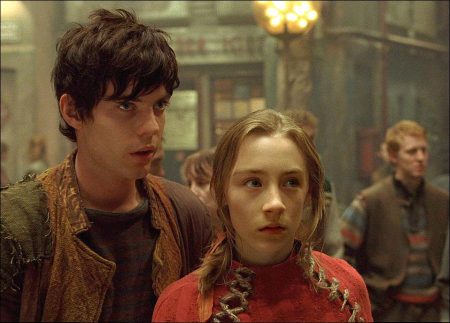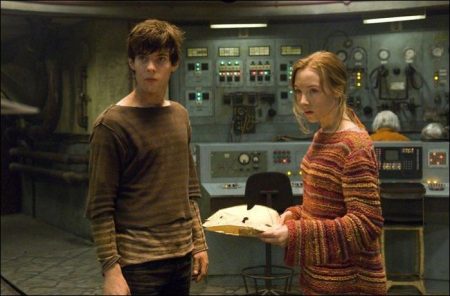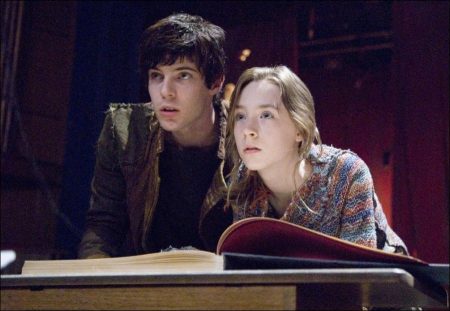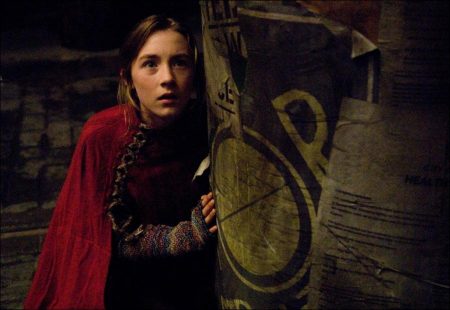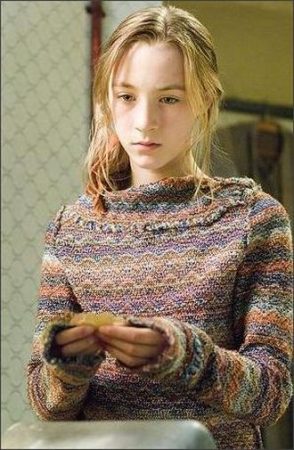Tagline: Escape is the only option.
For generations, the people of the City of Ember have flourished in an amazing world of glittering lights – underground. Built as a refuge for humanity and powered by a massive generator – this City will only sustain for 200 years. Now Ember is falling into darkness as the generator fails, and the dazzling lights begin to flicker and fade.
Despite growing concern for the future of their beloved City, Ember¹s students find themselves confronting the next step in their lives. A rite of passage for all graduates, it is Assignment Day, the day on which the Mayor himself will stand before the graduating students as they choose, by lottery, how they will spend their lives working for their society. Lina, praying with all her might to be a messenger, is devastated to be assigned to the Pipeworks, the vast network of pipes underneath the City.
Her classmate, Doon Harrow, who wants more than nothing else to work in the Generator, panics when he pulls the messenger assignment. The Pipeworks isn’t the Generator, but it is close enough and Doon offers to swap assignments with Lina. She is thrilled and grateful and eagerly changes jobs. Thus, an unlikely friendship is born, one that, as it blossoms, will change the course of all the lives in Ember.
Lina takes easily to the job of messenger and finds herself zipping all over Ember, delivering important missives to even more important people, including the mayor himself. At home she cares for her aging and forgetful grandmother, and her baby sister Poppy. When an old metal box is discovered in their closet, Lina¹s grandmother is overjoyed. Completely sure that the contents of the box are of the utmost importance, she is completely bereft of any memory as to why.
Citizen Biographies
A newcomer’s guide to who’s who in the City of Ember.
Mayor Cole
The Mayor of Ember follows a long succession of fearless visionaries that have led Ember and its citizens to prosperity, peace, and contentedness. Now, the City of Ember finds itself in peril which is an unfortunate fact that Mayor Cole does not seem near as concerned with the well being of his charges, the citizens of Ember, as he does with his own survival.
Loris Harrow
A brilliant inventor with a haphazard process, Loris Harrow has used his ingenuity and good standing amongst Ember’s citizens to slowly and quietly gather the secrets of the City. Is he ready to now pass them on to his son, Doon, so that Ember may be saved? Or has he resigned himself to his fate, bitterly blaming the builders for stranding him there for all eternity?
Lina Mayfleet
Orphaned as a little girl, Lina and her younger sister Poppy live in the care of their grandmother. With Granny’s health failing, young Lina now finds herself in a position of looking after both her sister and her grandmother. Having just finished her schooling, Lina has landed the assignment of Messenger, and she is ready to put her enthusiastic sense of civic duty to good use in the service of her fellow citizens. Descended from one of Ember’s early mayors, Lina finds herself in possession of one of Embers longest lost secrets, and is compelled to piece together the clues that will lead her people to safety.
Doon Harrow
A recent school graduate, Doon Harrow, son of Loris, has been assigned the job of Pipeworks assistant. Determined to discover the inner workings of Ember’s failing generator, Doon hopes to put his knowledge and his passion to use in solving the problems that plague his City and it’s inhabitants, and so finds himself on a journey with Lina through Embers darkest places, in search of light.
Barton Snode
Best described as Mayor Cole’s henchman, or perhaps lacky, Barton Snode shares the same questionable moral code as his boss. He spends his hours perched outside the Mayors office, managing traffic in and out, and will go to great – intimidating – lengths to preserve Mayor Cole’s dark secrets.
Clary
One of Ember’s few farmers, Clary runs a greenhouse on the outskirts of the City. She spends her days cultivating produce that will feed the people of Ember. Her job is an incredibly important one, as the City seems to be running out of additional food reserves. It is also an incredibly complicated job, as she is bereft of daylight and must rely on a carefully constructed system of artificial light to maintain her crops. Close with Lina, Clary is more than willing to lend a hand, when needed, to help Lina and Doon with their quest…and it is all done at her own risk.
Sul
Doon’s boss in the Pipeworks, Sul has been around longer than most Ember citizens. With an innate knowledge of everything within his sphere of work, it is clear that Sul has little interest in anything that isn’t considered his direct responsibility. It’s not his job! Which is a good thing, because Sul also suffers from severe narcolepsy, and can more often than not be seen asleep at the wheel…of the generator. But when needed in a pinch, Sul will definitely come through.
Before It Was A Movie, It Was A Book
“Welcome to the City of Ember. As a valued member of society, you have been chosen to keep the flame of humanity alive and burning brightly. Because of you, the human race can hope for a long and prosperous future.”
Jeanne DuPrau’s first real piece of fiction, she wrote The City of Ember back in the 80s, and says the idea for the story just appeared in her mind. “I grew up in the 50’s, and have strong memories of the shadow and fear of nuclear war. People everywhere were talking about what could happen. They were building bomb shelters. It made a huge impression on me.”
From this she developed a curiosity: what would happen if entire societies had to take refuge…somewhere else? Thus, Ember was born: a City built to protect the human race from a terrible threat.
Immediately upon reading the manuscript, director Gil Kenan knew that the number one character he was going to have to bring to life – his star- was going to be the City of Ember itself. “The City is a character in the story, with a beating heart and a nerve centre. Ember has been built as a place to keep humanity going through dark times, and the mystery at the center of our story, the mystery that unites all of our characters, is the secret of the City itself, and how it can be saved. ” says Kenan. “There is an emotional tie between all of us and the place we live, and City of Ember explores the complex and emotional relationship between the Ember citizens and each other, and the citizens and the City.” The challenge of making all this real, on screen, drew him to the project.
Leaving UCLA film school with a successful thesis film (“The Lark”) and a Hollywood agent, Kenan found himself in an introductory meeting at Tom Hanks’ and Gary Goetzman’s Playtone. Goetzman recalls, “he had done a film for UCLA Film School and it was fantastic and we showed him Ember and he seemed to have a really good take on the material.” At that meeting Kenan described the kind of film he wanted to make. “I envisioned a story set within a controlled environment, a kind of action adventure film,” he explains. “Immediately, the Playtone folk handed me City of Ember. I devoured it that night and called next morning to say I wanted to make the film. Three days later I was back at Playtone describing how I could make the movie.”
Hanks concurred “When I read the book I thought `my word, this is quite self contained and beautiful, and I’ve never seen or read anything like this before. I’m always looking for that thing where a bell goes off, and you read the most unique story with the most unique characters and unique circumstances. And this was it in spades.’”
Playtone optioned the book and Caroline Thompson was asked to write the screenplay. Thompson’s first produced screenplay was the magical award-winning “Edward Scissorhands”, and she has since directed her own work on screen. Says Kenan, “I had always admired Caroline’s work and knew she would be able to bring the humanity of the characters to life. I felt that the film should take a parallel but separate path from the novel.”
Hanks and Playtone were thrilled with the script she turned in. “In no time at all Caroline had come up with the perfect screenplay. Which does not happen very often. Everybody at the office felt as if we’d captured lightening in a bottle.’”
In the interim, Kenan was invited by Robert Zemeckis and Steven Spielberg to direct the film “Monster House”, which took three years to bring to the screen, and gained the director an Academy Award nomination for Best Animated Feature in 2006. During production of “Monster House”, Playtone continued to develop City of Ember for the screen. Director and production were ready by Summer 2007. Said Hanks: “You’re looking for someone who is rabid for the material. Gil was. And he had the goods. We just happened to bless our lucky stars and land on him, and he has it in his bones.” The cornerstone of Ember had been laid.
Before They Were Roles In A Movie, They Were Characters on the Page
When asked where the characters in the book came from, namely Lina Mayfleet and Doon Harrow, DuPrau has a simple answer: herself. “Doon and Lina are mostly me, as a child. Lina is imaginative; she runs; she draws. Doon is curious; he likes puzzles; he collects books. All these things describe my childhood.”
Producer Hanks is thrilled with the cast that was assembled to bring this story to the screen. “We ended up having this tremendous group of talented a guns. All the members of the cast and most of our filmmakers have already shown themselves to be very facile at telling this type of story. And when you have all of that along with this fascinating story, well then you really have something that you can latch onto that is more than the classic fantasy film. It’s the sum of all of its parts. And they’re impressive parts.”
Lina Mayfleet: Messenger, Savoir
Casting Lina, the teenage girl who, with her friend Doon Harrow, begins the quest that leads to the unlocking of the City’s secrets, was an arduous task. Says Kenan, “We travelled the world for six months, and only when I met Saoirse Ronan was I convinced I had heard Lina’s voice. Like Lina, Saoirse is a force of nature. She is a wondrous actor; I’ve never met anyone like her. She has absolute control over her gift; she can accelerate, hit the brakes and turn around – like a sports car. And the audience has that gravitational pull towards her eyes that happens with all the great screen legends.”
Director of Photography Xavier Perez Grobet echoed the sentiment. His first time working with Saoirse, he was struck by her abilites. “She’s a beautiful girl with a natural talent. It comes easy to her, it seems she never has to think about it. Somehow she always knows exactly where to stand, and exactly how to relate to the camera. A cinematographers dream!”
Saoirse adored the script. “Lina is very determined. Nothing will stop her once she decides on a course of action – that’s what I like about her. She has her job, and she also has to look after her baby sister Poppy and her grandmother, so she has a lot of responsibility and is quite mature for her age. She loves her job – running around the City delivering messages. She loves the people she meets.
Everyone there has to be very inventive, as there is nothing in the shops, and they have to be creative to keep everything going; nothing can be thrown away or wasted. And there is no television in Ember, so they have to make their own entertainment.” Thrilled with the experience of working alongside Harry Treadaway, Saoirse now describes him as her best friend.
When asked if Saoirse was what she had hoped and expected for her beloved character Lina, Jeanne DuPrau was effusive. “I had just seen Atonement and thought Saoirse was wonderful, so I was very pleased.”
Doon Harrow: Brave Collaborator
Lina’s ally and friend is Doon Harrow, a character who proved an equal casting challenge. The young and vibrant actor Harry Treadaway was entrusted with the task of bringing this conscientious character to life on screen.
Says Kenan, “Doon is interesting. He’s not outgoing and affable. Instead, he has a lot on his mind. It takes a performer with charisma to deliver that to an audience while keeping their sympathy. Harry can do that, and in doing so makes Doon the perfect foil for Lina. You can believe their relationship on screen.”
Reflecting on his character, Harry says “Doon is sure he can contribute to the good of the City, and when he becomes convinced that the generator is ailing, despite the Mayor’s assurances to the people of the City, he wants to be involved in sorting things out.” He also points out the environmental parallels that exist between the people of Ember and society today, overtaxing our planet’s natural resources. “In Ember some people prefer to ignore what’s going on, just as people ignore the effects of climate change today, but Doon believes that each person can make a difference, and he proves that’s true.”
This sentiment rings true with Ember’s creator, DuPrau. “I wanted to, through the story, highlight the preciousness of the natural world, and how fragile it is. We have the power to destroy our planet, and in telling this story to all generations – and mostly young people – I want to send the message that we have the great responsibility of protecting our environment.”
Equally delighted to have worked with Saorise, Treadaway also praises the experience of working with director Gil Kenan. He in particular admires Gil for his ability to tell the story through the eyes of his young characters. “Gil has infused every character with light.”
Mayor Cole: Untrustworthy Captain
Bill Murray tackles the role of Mayor Cole, whose surface affability is beginning to crack as Lina and Doon delve into the secrets of the City. “Bill Murray has so much energy, and brought a humanity to the Mayor as he is being exposed as a bit of a villain, which is what I had hoped for. You’ve got to be able to see the charisma in a politician, even as he is doing terrible things,” says Kenan.
Saoirse muses on how much she enjoyed her scenes with Murray; “He likes to joke around, and spent a lot of time trying to make me laugh while I was doing my lines to camera. Everyone’s spirits got higher when Bill walked on set. He can’t help being entertaining.” Murray himself praises his young director and co-star. “Gil is a smart and enthusiastic director. His job requires a lot of constant energy, and yet he manages to be very supportive and very generous every step of the way. He creates an atmosphere where actors feel comfortable enough to fail, which in the end only allows everything to come together better.”
He adds, “Saoirse has big blue eyes that make you look at her and wonder what is going on. Everyone is drawn to her, and she has a wonderful spirit. Nothing seems to stop her from connecting with her own intelligence and emotions.”
A long time fan of writer Caroline Thompson’s work, Murray points out, “this film has a lot going for it: a wonderful script, a good director, great cast and fantastic set design and costumes – truly inventive. So often the costumes are re-creations from history, but costume designer Ruth Myers really nailed the look for this; the clothes are great. I think a film crew always knows what’s really going on, and on this production, all the crew were always on the set all the time, enjoying the action.”
Loris Harrow: Ingenius, Indecipherable Inventor
Kenan was delighted to be able to cast Tim Robbins as Loris Harrow, Doon’s father and an ingenious inventor who makes robots and machines from the discarded debris of the City. “Loris is very important for giving us a perspective on who Doon is in a very short time, so the scenes of father and son at home are really vital. Tim brought a real gravity to the role.” says Kenan. Adds Harry Treadaway, “Those domestic scenes with Tim and Loris were great to anchor Doon’s domestic life. We discussed what their life was like before the story starts.”
Robbins describes his character. “Loris is a man who is a tinkerer, an inventor, and drives his son crazy. Loris has a secret from his past, from when he dreamed of another life. He hasn’t given up on this dream completely, but he encourages his son to think about things that other people in Ember don’t want to think about.” Praising director Gil Kenan, he says, ”The scale of this film is a big undertaking for a young director, but Gil has vision, passion and excitement. You can’t ask for more.”
DuPrau, herself an illustrator with very specific ideas about what each of her characters looks like and embodies, also had words of praise, this time for Robbins. “I’m thrilled he was cast – he comes pretty close to exactly what I thought Loris would be like.”
The Other Citizens
An incredibly strong and varied cast of actors fill out the film’s supporting roles, adding an entire additional level of depth and cache to the project. The UK’s beloved Liz Smith takes a turn as Lina and Poppy’s ailing and scatterbrained Granny. With the cluttering of her mind over her many, many years Granny seems to know that she holds the key to save the citizens of Ember, but for the life of her cannot remember what it is that she knows.
Toby Jones plays Mayor Cole’s smarmy and crooked side-kick Barton Snode. Jones brings just the right mix of humour, gravity, and false concern to the character – as if he himself had been a politician, and this wasn’t his first cover-up.
Marianne Jean-Baptiste is Clary, the greenhouse keeper and Lina’s confidante, who risks everything because she believes in what Lina and Doon are striving to accomplish. Emmy Award winner Mary Kay Place plays eventual guardian to Lina and Poppy, Mrs. Murdo. A believer in Ember and it’s Builders to her core, Mrs. Murdo is the very definition of faithful, and as her world crumbles around her she is able to take solace in her faith and her fellow Ember mankind, knowing that their Maker has a plan to guide them to safety.
Mackenzie Crook, best known for his searing portrayal of Gareth in the BBC’s “The Office” continues his blossoming career onscreen in Ember, taking on the role of Looper. A shady, black-market player, Crook deftly turns Looper into a creepy self-serving operator with nothing but bad intentions.
Rounding out this impressive list is veteran Academy Award winner Martin Landau. Landau appears as Sul, Doon’s ancient and narcoleptic mentor in the Pipeworks who does more to aid in Doon and Lina’s quest than he would ever care to imagine. Landau’s incredible sense of comic timing adds a strain of levity in otherwise tense and exciting moments of the film.
Before It Was A Completely Self Contained and Functioning City, It Was A Sound Stage
For Kenan, the design of the City itself was as important as casting his characters. He explains, “The City of Ember is a character in the movie, and all the action and puzzle solving is centred on saving the City, so it was vital that production designer Martin Laing and I built something as realistic as possible.
We began by putting ourselves in the position of The Builders, the founding fathers of the City, who hastily built this City to protect their citizens from an unexplained harm, and guessed what they might need to remain sheltered there for at least two centuries. When it was built the City was technically advanced, reliant on self-sustaining energy from the generator powered by the river, and with the people organized to undertake a joint community effort to sustain the generator. When our story starts, the City has passed its “expiration date” and all the provisions laid down by The Builders have begun to run out.”
For the design of the City itself, director and designer decided that the original builders would have taken a utilitarian approach. “The jumping off point was that this was a space designed as purely functional, to shelter the population, but people have been living there for more than two hundred years, so you can see that the resourcefulness of the citizens has changed the core design, and the space has evolved organically. The buildings have changed, and what once may have been shiny and industrial is now shabby and rundown. That’s our Ember.”
Says Hanks, “It’s the story of this City, a world that’s defined, that’s got its own life, that was designed as a perfectly functioning, technologically savvy habitat for humanity.” Finding a space large enough to accommodate all that the filmmakers had in mind meant scouring the world for a gigantic studio. Eventually, the production landed in The Paintworks, a hangar which the Harland and Woolf ship building company of Belfast, Northern Ireland, had used to paint the hulls of the large ocean going ships they made in the adjoining docks.
Martin Laing had worked with director James Cameron on his epic block-buster “Titanic”, and so it was poetic when he found himself in the actual dock where the ship itself was painted. “I felt at home immediately, since a year of my life was spent recreating the Titanic, albeit in a studio in Mexico. But from photographs and artefacts, Belfast docks were very familiar to me.” The height of The Paintworks, at over 90 feet, allowed the production to build a continuous City, with buildings three stories high, a grand square with streets leading to smaller squares and many nooks and crannies. Goetzman sums up: “the sets are HUGE. They are so huge!”
For Laing, the challenge was to build a whole City, something that has not been done before outside a studio back lot. “Usually, a film like this would use a series of stages, but we built a working City and then aged it 250 years. The layout of the City is based on concentric circles, like the wheel of a bicycle, with the centre, Harken Square, having the spokes spread out as streets.
As we imagined that the City had been built quickly, all the decorative features which might be on these buildings were stripped out and we ended up with a modernist, straight look.” The heart of the City is the generator, which Laing designed to literally resemble a heart. “It’s a big rusty red behemoth, with pipes everywhere, resembling the veins.”
He explains. “Although the structure of the buildings is fairly basic, we did include some references to the inhabitants. If you look at Granny’s shop and apartment, the outside windows and ledges look like an old face, and the interior of the wool shop shows all the materials unravelling, just like Granny’s life. Loris Harrow’s apartment and shop are chaotic, like his life, and the Mayor’s Gathering Hall is as big and ostentatious as the Mayor.”
He adds, “Many of the buildings have undergone a change of use- the telephone exchange is now the messengers headquarters, because the phones don’t work and any messages have to be sent by hand.” Hanks was equally impressed by the undertaking. “The world of Ember, the City of Ember, is a one of a kind, unique singularity. It has a logic to it that comes out in every pipe, every wire, every frame, every faded sign, every chipped piece of paint on every crumbling wall. The mass of sets that was built by this team was a magnificent piece of art direction that was put together and played from one end to the next, all in unison.”
Kenan and Laing have added many small touches to reflect life in Ember – a shoe shop selling only one shoe, a scissor shop with only one pair left in the window, the Laundromat where the machines no longer work and the clothes are washed by hand, and a clothes shop with nothing left to sell. The audience may also catch a glimpse of portraits of the various Mayors of Ember, as Barton Snode accompanies Lina on her first visit to Mayor Cole. Included amongst the illustrious former mayors of Ember are screenplay writer Caroline Thompson, novelist Jeanne Duprau, executive producer John Schofield and Gil Kenan’s grandfather.
Goetzman reflects “with all the movies Tom and I have been involved in at Playtone I don’t think anything has had the scope, this amount of fire-power, this amount of set building,. It’s just been a huge undertaking. And, you know, to think that Gil Kenan at his bright young age was able to really corral in all these elements that we needed for the picture is just a real testament to what a great director he is.”
Before They Were Costumes: They Were Sketches
Costume designer Ruth Myers had worked with Kenan before on “Monster House” and Kenan said that “she did such a great job designing virtual costumes for that film, that I knew we had to work together with real materials on this one.” For Ruth and her team, the challenge was that every single costume had to be designed and made. “We’re working in a unique world, where there are no obvious references. I’m used to working on fantasy films, but this is different from anything else – it’s a kind of organic science fiction.”
Says Ruth. “The people of Ember are a living community, and I like these people, so it is easy to design from a position of fondness.” Collaborating with Gil, she knew the director had some affinity with clothes of the ’50s and the `70s, and his ideas on colour schemes leant towards the `70s. She adds, “Gil is visually very sophisticated. He sees things in pictures, and is the perfect conduit between departments, so that we all knew exactly what each department was doing in terms of style and colors.”
“These people are all clad in work clothes which, because of the shortage of raw materials, are all more than fifty years old, so they’ve all embellished and altered their uniforms and overalls. People always have a personal sense of style so, for instance, Looper has added a life jacket to his outfit; the Mayor has a suit made from pieces four other well-worn suits and Lina wears a lot of knitted bits, because Granny runs the wool shop and would be able to provide those garments.”
Making the clothes was a mammoth task, as Ruth and her team in Belfast made each outfit, for 400 extras as well as the principals, from scratch. “We had a wonderful time, turning things inside out, patching clothes with any material we thought would be available – rubber piping, soft furnishings, even carpet. If you look closely you’ll see that the Mayor’s guards’ armour is made from linoleum. You can inject a lot of gentle humour into clothes like these.”
Before There Was Light, There Was Darkness
For Director of Photography Xavier Perez Grobet, City of Ember proposed a particular challenge. It was Grobet’s job to bring light to the City of Ember, and in turn light to the screen. The entire movie was shot without a single ray of sun, and the central theme of the movie is light, or, rather, fear of loss of light. DuPrau underscores this when she discusses one of her driving motivations for writing the book.
“I was interested in the idea of a City that had no light other than electriCity. What would it be like to live in such darkness, and to know that light and food and supplies were all running out? And not to know about weather or trees or animals or any other places? All this grabbed my imagination.”
As it did Grobet’s. Grobet and Kenan had worked together once before, on Monster House. “The fact that we knew each other already, and came to the project with an understanding of how we each work, what we like, what we don’t like…this made it a natural fit,” says Grobet. “When Gil came to me and showed me the graphic ideas, and the look he wanted to go for it completely appealed to me, especially from a lighting standpoint. The entire movie was about lighting! There was so much there for me to explore.”
Furthermore, the fact that the entire set was a functioning City – meaning if a scene was shot in Granny’s apartment, then it was actually shot in her apartment on the second floor of a building on a street in the City of Ember – only deepened the challenge for Grobet. “It was such a challenge to move the camera freely and accomplish a certain perspective with all of these limitations – incredibly dark and tight spaces, sets within sets, and artificial lighting. I had to find many different ways of getting the light we needed to make the shot.” Grobet in particular remembers one scene in which he had to get creative with the lights on a kitchen counter in one of the apartments, all the while making it look like it belonged in the residence.
But despite it all, or perhaps because of it all, the project was right up his alley. So different from most of his previous films, he felt he was able to draw on all of his past experience to come up with the creative ideas and solutions – both artistic and practical – he needed to make it all workable. The result is exactly what you see on screen.
City of Ember: Hope Comes to Life
Full of action, full of adventure, and driven by the message of hope and courage, City of Ember has had so much to offer to filmmaker and cast alike. It was these themes that in part drew Tom Hanks to the project. “Lo and behold if it isn’t the young people of the City of Ember, the young people who are always yearning for something better or always asking why are things the way they are and isn’t there something better out there for us as we get older. These young people are the ones who discover the secrets. They go off and not only do they make their lives better, but they save the entire City.”
But even beyond the uplifting themes, Ember is just plain exciting to watch. Continues Hanks “It’s a big massive puzzle that starts with a hint, that leads to clue, that leads to a trail, that leads to a secret, that leads to a passageway that leads to a tunnel that leads to a fantastic adventure.”
Gil Kenan says,” It spoke to me on every level that I want to work on as a film-maker- a unique visual self-contained world, characters full of light and life, and a plot full of mystery.” This special project now brings excitement to the theatre, where its universal themes, dynamite cast, creative design, and uniquely told story will appeal to filmgoers of all ages.
City of Ember (2008)
Directed by: Gil Kenan
Starring: Bill Murray, Tim Robbins, Saoirse Ronan, Toby Jones, Harry Treadaway, Miles Thompson, Rachel Morton, Eoin McAndrew, Mackenzie Crook, Lucinda Dryzek, Maureen Dow, Marianne Jean-Baptiste
Screenplay by: Caroline Thompson
Production Design by: Martin Laing
Cinematography by: Xavier Perez Grobet
Film Editing by: Adam P. Scott
Costume Design by: Ruth Myers
Set Decoration by: Celia Bobak
Music by: Andrew Lockington
MPAA Rating: PG for mild peril and some thematic elements.
Distributed by: 20th Century Fox
Release Date: October 10, 2008
Views: 108
